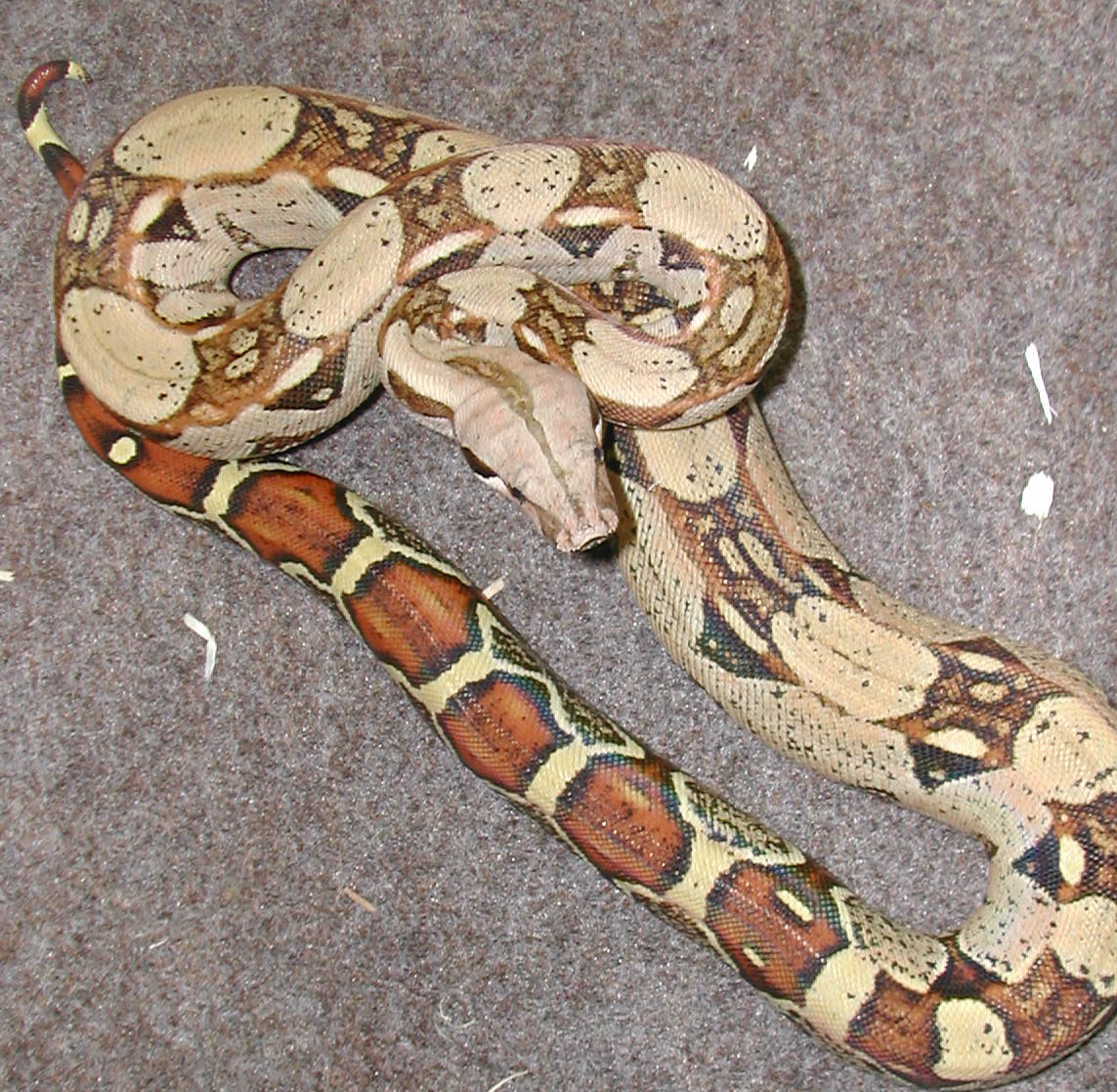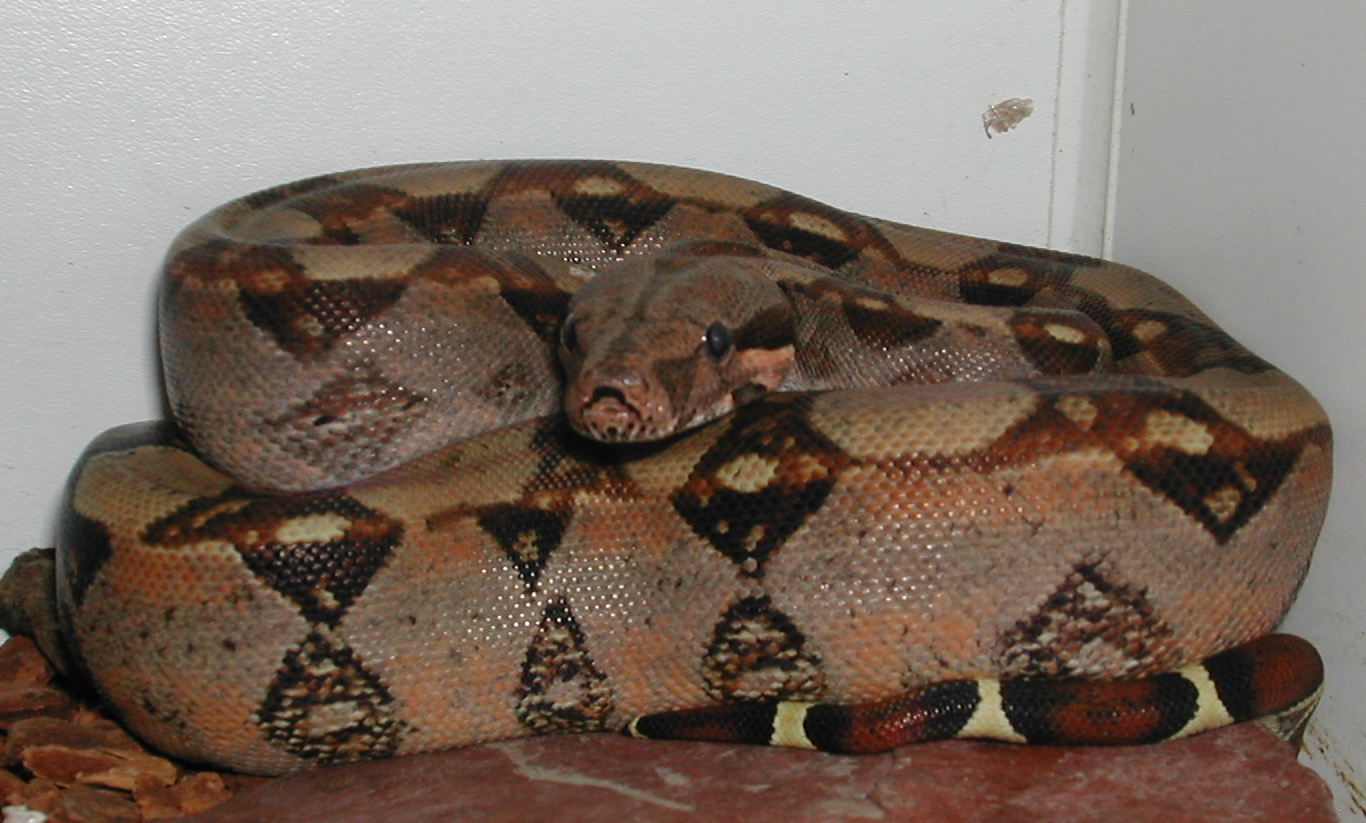|
Care of your Boa constrictor

Hatchlings- If you are interested in purchasing a baby Boa, there are many options to consider. There are many different species of Boas and often a number of localities within each species that differ in color, size, attitude, and price. Captive breeding efforts have led to further color variations as well, such as albino, anerytheristic, snow, hypo, sunglow, square tail, striped tail, etc. For our purposes here, we will assume that you are interested in a common Boa constrictor or Red Tailed Boa.
Hatchling boa constrictors can be comfortably housed in a 20-gallon aquarium (the 20 "long" is preferable), but keep in mind that they will out grow this enclosure rather quickly. An adult will often require a cage that is approximately 8 feet long by 2 to 3 feet wide by 4 feet tall. A custom built cage is likely your best option at that time. Newspaper, reptile carpeting, aspen shavings, and cypress mulch all make decent substrates for boas. I use and recommend aspen shavings as an excellent substrate. If using shavings or mulch, it is not recommended to feed on the substrate since ingestion of the shavings could cause impaction. Daytime temperatures should be 80° to 85° F with a basking temperature up to 95° F. Night time temperatures should be allowed to drop a bit to 75° to 80° F. Boa constrictors do well with a 12-hour light, 12-hour dark light cycle. UV light is not necessarily needed. Ambient cage temperatures and basking spots can be maintained with the use of under-the-tank heaters, basking bulbs, or ceramic emitters. Do not use high wattage bulbs (greater than 100 watts) or hot rocks because as these may cause burns to your boa.
Healthy babies feed regularly on
appropriately sized rodents. The right size food item is
often a little larger than the
snakes own head and the snakes
ability to disengage its jawbones
and stretch around the prey item
allows the snake to accomplish an
amazing eating feat. Even baby boas are usually large enough to eat rat pups or small mice from the start. A vitamin and
mineral supplement can be added to
the prey item just prior to
feeding. Dusting the rear
end of a frozen/thawed rodent with a vitamin/mineral powder is the best way to accomplish this.
Baby snakes may be fed twice a week
for the first few weeks to get a
good body weight initially, but
then cut it back to once weekly. I
recommend keeping a small water
bowl available at all times for
baby snakes, just be sure to clean
it regularly.
Adults- The adults are
maintained using the same requirement guidelines, just on a larger scale.
Using a larger prey item, feedings
can be scaled back to every 7 to
10 days throughout the warmer
months of the year. They don’t
need vitamin supplementation quite
as often either, maybe with every
other to every third feeding. I
often supply water to adult snakes
once or twice a week and then
remove the water bowl as they tend
to spill the water or defecate in
it.
 General-
Boa constrictors are large snakes, often reaching lengths of 8 to 12 feet and weighing in the range of 30 to 60 pounds. Females tend to be larger than males. These snakes are native Mexico through South America, including the surrounding islands. If properly cared for boa constrictors will live 20 to 30 years in captivity. These snakes are bred in large numbers in the US and in many other countries and finding a captive bred animal is easier than finding an imported one. Babies are born live, another attractive quality to those that breed them, as there is no need to incubate and wait for eggs to hatch. General-
Boa constrictors are large snakes, often reaching lengths of 8 to 12 feet and weighing in the range of 30 to 60 pounds. Females tend to be larger than males. These snakes are native Mexico through South America, including the surrounding islands. If properly cared for boa constrictors will live 20 to 30 years in captivity. These snakes are bred in large numbers in the US and in many other countries and finding a captive bred animal is easier than finding an imported one. Babies are born live, another attractive quality to those that breed them, as there is no need to incubate and wait for eggs to hatch.
Boa constrictors may be a little defensive as babies, hissing and striking at movement around them. However, with a bit of handling and consistent kind contact with humans, they quickly become one of the most docile, placid, and trustworthy snakes you could imagine. They have wonderful dispositions and are a fascinating snake to keep and observe. These qualities have made them one of the most enduring snakes in herpetoculture.
Other Helpful Info:
̃
Always buy a healthy captive
bred animal and learn as much as
you can from the source that you
are buying it from, such as age,
sex, what is it eating, etc.
̃
Find a local veterinarian who is
knowledgeable about reptiles before
any problems arise!
̃
Buy a good book about Boas or at least a book with a
decent section about these
animals and keep it on hand for
reference. This care sheet
contains only initial
information to get you started
and is by no means complete.
̃
Enjoy your Boa! These are
fun and interesting pets.
Other references or recommended reading:
The General Care and Maintenance of Red Tailed Boas by Philippe de Vosjoli
The Boa Constrictor Manual by Philippe de Vosjoli, Roger K. Dum, Jeff Ronne
Reproductive Husbandry of Pythons and Boas by Richard Ross and Gerald Marzec
|